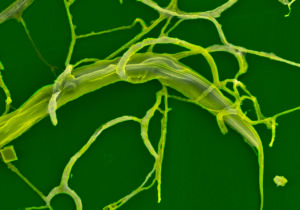Project Overview
Commodities
- Animals: goats, sheep
- Animal Products: meat
Practices
- Animal Production: animal protection and health, genetics, grazing management, parasite control
Proposal abstract:
Grazing with the Fun Guy (or fungi). This project will show it is possible to provide a strategy to offer the fungus (see photo of parasite larvae trapped by Duddingtonia flagrans fungus), which controls gastrointestinal worms on pasture leading to improved animal health and productivity, and enhancing sustainability of livestock farms.
Since our first SARE R&E grant in 2002 (LS02-143), we have strived to include nematode-trapping fungus (Duddingtonia flagrans or Df) in the toolbox for livestock producers to control gastrointestinal nematode (GIN) parasites. However, commercialization of the fungus (BioWorma®) took 17 years! GIN are the major health threat for ruminant livestock confounded by dewormer resistance, leading to anemia, poor weight gains and death. The goal of sustainable farms is to eliminate chemical inputs and control GIN; the fungus brings this closer to reality. The fungus can remove much of the GIN on farm. Approximately 90% of GIN are found on the pasture and 10% in the animal; Df can reduce up to 90% of larvae on pasture. The product is considered costly by most farmers (between $0.20 to 0.60 per 100-pound animal per day). Thus, it is imperative to build a strategic program for farmers that considers effectiveness and economics. For example, can Df be fed every other day, or every other week or only in loose mineral supplements? These questions will be answered in research flocks/herds and on farm by examining changes in fecal egg counts, pasture larval counts and/or animal worm counts.
The fungus as part of the farm system will be considered among other management tools to minimize worms and optimize animal health. These include genetic resistance to lower GIN infection and increase economic value (current grant, OS19-124), and use of copper oxide wire particles (COWP) as a dewormer (included in CVs of PIs). These can lead to reduced time spent on GIN management, increased animal growth and production since the immune system is not overburdened, and a greater regenerative agriculture potential without the reliance on chemicals.
We have a rich outreach program through the American Consortium for Small Ruminant Parasite Control (www.wormx.info) which meets twice yearly including virtual meetings. Dr. Whitley is a small ruminant specialist with a strong extension program providing several farmer training sessions yearly (virtual or live) and on an ACSRPC extension committee to produce videos, fact sheets and translation of farmer publications to Spanish. We will communicate with K. Matthews, Delaware State University (LNE21-418), an ACSRPC member also investigating the use of Df. Thus, we can disseminate findings and build recommendations for use of the fungus in the farm system. We will work with Susan Schoenian, University of Maryland (expected to retire) ACSRPC website developer, on progressive development of the ACSRPC website to gauge the frequency of use of materials on the site. We will explore ACSRPC on Facebook and develop more infographics and sound bites of information to lead to more in depth info on the website.
Project objectives from proposal:
- Examine practical approaches to administer Duddingtonia flagrans (Df) to sheep and goats to obtain good gastrointestinal nematode (GIN) control.
- Examine complementary approaches of using genetics, Df and other GIN control technology within the small ruminant grazing system.
- Develop new outreach materials as fact sheets, videos and webinars in collaboration with farmers, and increase use of available technology for GIN control to disseminate strategies of GIN control that minimize the need for deworming.
